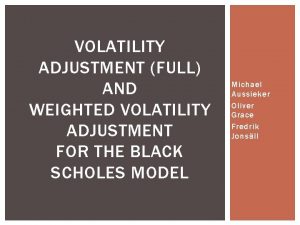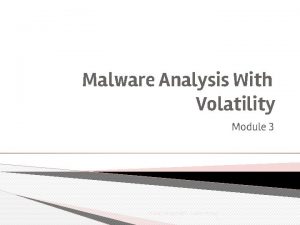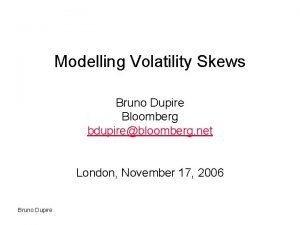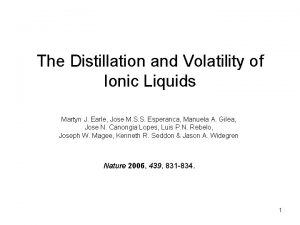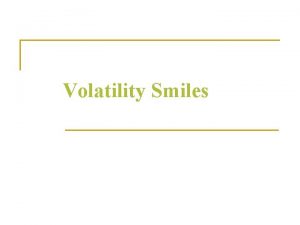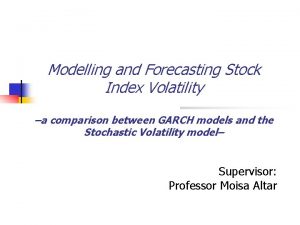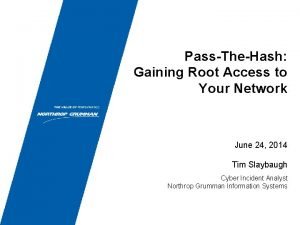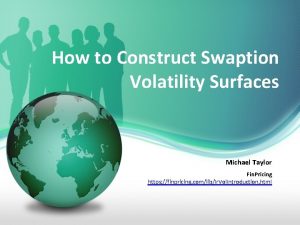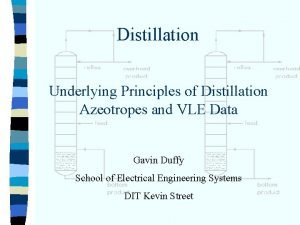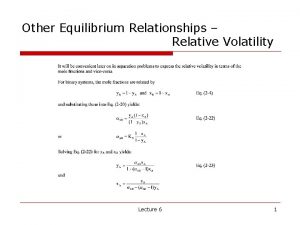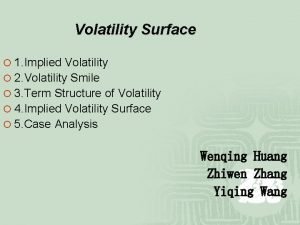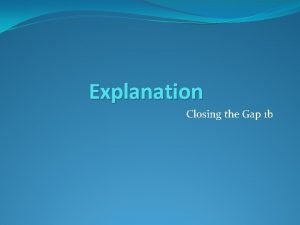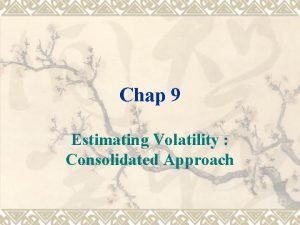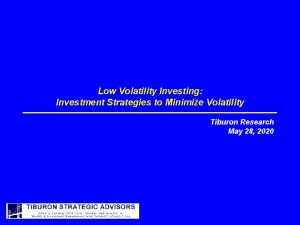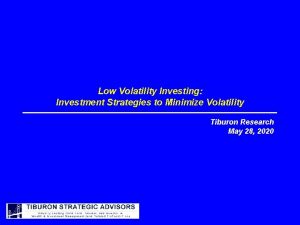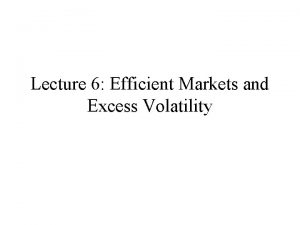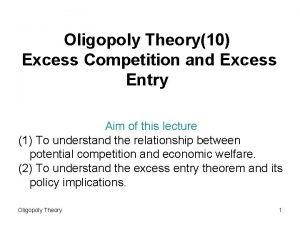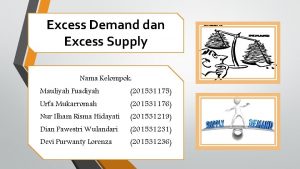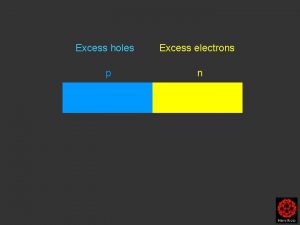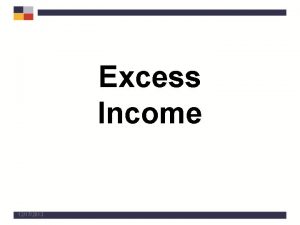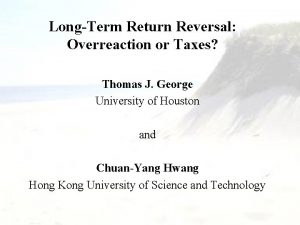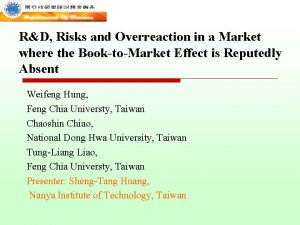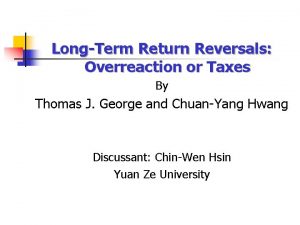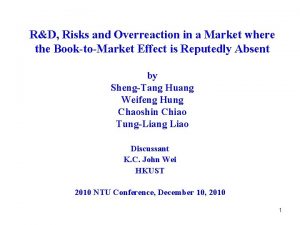Extrapolating Expectations An Explanation for Excess Volatility Overreaction





















- Slides: 21

Extrapolating Expectations: An Explanation for Excess Volatility, Overreaction and Limited Information Albany-MIT System Dynamics Colloquium Mila Getmansky Jannette Papastaikoudi April 5, 2002 1

Efficient Capital Markets • The efficient market hypothesis (EMH) has been one of the cornerstones of modern financial theory • Price is a martingale, conditional on all available information • Price changes are unforecastable if properly anticipated; i. e. prices fully incorporate the expectations and the information of all market participants 2

Yet Some Facts Speak Against EMH • Excess volatility exhibited in financial markets, i. e. the variation of stock returns cannot be explained by the variation in fundamentals (earnings/dividends) • Excess volatility is equivalent to predictability in stock price • One form of return predictability is momentum • Momentum in general refers to the tendency of stocks that had positive (negative) abnormal returns to continue to outperform (underperform). This implies a positive autocorrelation in returns 3

And What About Information Transmission? • Financial analysts are information intermediaries in markets, influence informational efficiency • Speed which prices reflect public information increases in analyst coverage • Yet, evidence shows, analysts reports are systematically biased. Why? • Optimistic reports generate investment banking • Biasing upwards allows for increased management access • Inexperienced analysts overreact to good/bad news 4

Put Two And Two Together • Combine all three research topics • Explain excess market volatility by means of momentum and incomplete information • Recognize behavior of market participants and its effects on investors wealth • Effect of excessive price movements with respect to fundamentals can be caused either by “irrational” trend chasing behavior of investors, or by distorting the available information used to form fundamental prices 5

Related Literature • Excess volatility: – Shiller 1981 – Campbell & Shiller 1988 • Momemtun: – Jegadeesh & Titman 1993, 2001 – Daniel, Hirshleifer & Subrahmanyam 1998 • Analyst coverage: – De Bondt & Thaler 1990 – Easterwood &Nutt 1999 – Hong, Lim & Stein 2000 – Lim 2001 6

Goal • Formulate a model of financial market volatility that is grounded in the system dynamics approach to modeling decision making • Explain excess volatility and price oscillations (excess volatility = volatility of return – volatility in the trend in earnings) 7

Assumptions • Two types of assets: risky and riskless • Market making mechanism is built into the price formation process • Two types of investors: value and momentum • Inexperienced analysts 8

Pricing 9

10

Momentum Investor Decision 11

12

Change in Investors Type Fraction Equal fraction: Investors Type Fraction = 0. 5 Fundamental dominates: Investors Type Fraction = 0. 8 Momentum dominates: Investors Type Fraction = 0. 2 13

Change in Investors Type Fraction Equal fraction: Investors Type Fraction = 0. 5 Fundamental dominates: Investors Type Fraction = 0. 8 Momentum dominates: Investors Type Fraction = 0. 2 14

Momentum Investors Lose on Average Fundamental Dominates: Investors Type Fraction = 0. 8 Momentum Dominates: Investors Type Fraction = 0. 2 15

Momentum Listening to Inexp. Analysts Reduces Exc. Vol. Investors Type Fraction = 0. 2 Momentum Dominates: Momentum Weight = 1 Momentum Listens to UA: Momentum Weight = 0. 5, UA Weight = 0. 5 16

Reducing Excess Volatility Investors Type Fraction = 0. 2 Momentum Dominates: Momentum Weight = 1 Momentum Listens to UA: Momentum Weight = 0. 5, UA Weight = 0. 5 17

Fundamental Listening to Inexp. Analysts Increases Excess Vol. 18

Increasing Excess Volatility 19

Conclusions • Excess volatility cannot be explained by EMH • Excess volatility is primarily due to speculative investors who chase market prices • Decision rules and bounded rationality of investors lead to the overall oscillations in prices and excess volatility 20

Conclusions • Momentum investors are not driven out even if most of the traders are fundamental investors (80%) • Excess volatility is higher when initially there are momentum traders than fundamental ones • Excess volatility is increased when fundamental investors listen to inexp. analysts • Excess volatility is decreased when momentum investors listen to inexp. analysts 21
 Overreaction
Overreaction Volatility adjustment
Volatility adjustment Procdump volatility
Procdump volatility Volatility skew
Volatility skew Volatility of ionic compounds
Volatility of ionic compounds Distillation types
Distillation types Volatility psscan
Volatility psscan Volatility smile
Volatility smile Volatility modeling
Volatility modeling Wce.exe
Wce.exe Swaption volatility surface
Swaption volatility surface Bu vle
Bu vle Relative volatility
Relative volatility Sju principer för tillitsbaserad styrning
Sju principer för tillitsbaserad styrning Bat mitza
Bat mitza Expektans eller exspektans
Expektans eller exspektans Tack för att ni lyssnade bild
Tack för att ni lyssnade bild Sju för caesar
Sju för caesar Shingelfrisyren
Shingelfrisyren Vad är verksamhetsanalys
Vad är verksamhetsanalys Typiska novell drag
Typiska novell drag Matematisk modellering eksempel
Matematisk modellering eksempel

